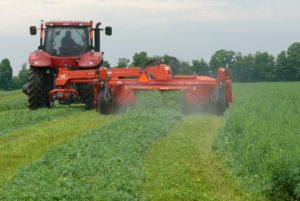 Soil moisture levels are variable across the province, with some areas having adequate moisture with good forage growth, while others with little rain are dry with shorter than normal stands. Grass growth has been more affected by the dry weather than the alfalfa. Many alfalfa stands harvested during the Critical Fall Harvest Period are showing less aggressive growth this spring. New seedings were done relatively early under excellent conditions, but the lack of rain in some areas has delayed germination, growth and herbicide weed control. Some light frosts have done very little damage. (“Frost Damaged Alfalfa” https://fieldcropnews.com/?p=6812)
Soil moisture levels are variable across the province, with some areas having adequate moisture with good forage growth, while others with little rain are dry with shorter than normal stands. Grass growth has been more affected by the dry weather than the alfalfa. Many alfalfa stands harvested during the Critical Fall Harvest Period are showing less aggressive growth this spring. New seedings were done relatively early under excellent conditions, but the lack of rain in some areas has delayed germination, growth and herbicide weed control. Some light frosts have done very little damage. (“Frost Damaged Alfalfa” https://fieldcropnews.com/?p=6812)
Timing 1st Cut
Dairy producers are monitoring alfalfa maturity and haylage harvest will be in full swing in many parts of the province the week of May 25th. Some winter cereal forage and Italian ryegrass have been harvested. Alfalfa stands are quite variable in height and growth stage depending on stand health and soil moisture. Dairy producers generally target harvesting first-cut alfalfa haylage at an optimum 40% NDF. This is considered a good balance between the conflicting goals of:
- digestible energy,
- protein utilization,
- adequate dietary fibre (rumen function) and
- yield per acre.
Ideally, the haylage should be 40% NDF at about the mid-point of the harvest. “Scissors-cut” field sampling, overnight courier and rapid laboratory analysis can help predict optimal alfalfa harvest dates. “PEAQ stick” estimates of NDF are also useful. If practical, delaying harvest of stressed fields will improve plant health and increase yield. In mixed stands, be sure to watch the maturity of the grasses when making cutting decisions. (Using Scissors Cutting & PEAQ Sticks To Optimize Forage Quality https://fieldcropnews.com/?p=2610)
Fall Rye & Triticale
The most advanced fall rye is at the boot stage to headed in the south-west on May 21st, with triticale slightly behind. Forage quality, palatability, and intake drop very quickly with rye at the heading stage (faster than other cereals) so the optimum harvest window is very narrow. Many dairy farmers target harvest at the flag-leaf stage for high nutrient quality. (Double Cropping Fall Rye For Extra Forage” https://fieldcropnews.com/?p=5241)
Planting Corn Silage After 1st Cut?
Some alfalfa fields suffering from winter injury are being harvested early to be planted into corn for silage. Be aware that adequate moisture and planting as soon as possible are essential to a reasonably successful corn silage yield. (Corn Planting Following Early Hay Harvests www.omafra.gov.on.ca/english/crops/field/forages/corn_earlyhay.htm)
Alternate Forage Options
New seedings of alfalfa mixtures and cool-season forage species such as cereals and peas done after mid-May do not do well in hot, dry summer weather. Summer seedings of alfalfa are typically more successful than late spring seedings. (“Summer Seeding Alfalfa” https://fieldcropnews.com/?p=3316) After late-May, a better option to produce a decent yield of summer forage is to plant some warm-season forage such as forage sorghum and sorghum-sudangrass. These can yield well with good agronomics and harvest management. (“Forage Sorghum-Sudangrass” http://www.omafra.gov.on.ca/english/crops/facts/98-043.htm )
Pasture by Jack Kyle, Grazier Specialist, OMAFRA
Grass growth continues to be slow but maturity continues to advance. Orchardgrass is headed and should be grazed immediately to maintain quality and stimulate new leaf development. Moving livestock to new paddocks when they have grazed half of the available forage will assist in managing this early growth and set your pastures for continued growth during the coming months. High stock densities can assist with weed control, especially early in the season when weeds are lush, vegetative and more palatable than when they begin flowering.
Monitor cattle on pasture and be on the lookout for any potential problems. The variable growing conditions this year may be a precursor to grass tetany. Providing a mineral that includes magnesium will help reduce the risk of grass tetany. (http://www.omafra.gov.on.ca/english/crops/pub19/Publication19.pdf, p. 57)